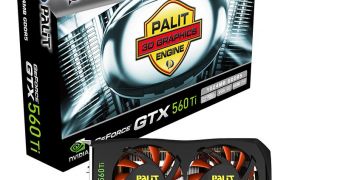NVIDIA just released the first 500 series mainstream graphics adapter and, to distinguish itself from its rivals, Palit came out in force, with no less than three boards, two of which depart quite visibly from the so-called norm.
With the GeForce GTX 560 Ti finally official, NVIDIA's various manufacturing partners, like Zotac, have begun to release their own versions.
Palit decided it would cause a tide instead of just a little wave, however, so it prepared three cards, dubbed GTX 560 Ti Sonic, GTX 560 Ti 2GB and GTX 560 Ti.
The latter is, of course, the one that sticks to the reference specs, with GPU, shader and memory clocks of 822 MHz, 1,645 MHz and 4,008 MHz, respectively.
The GTX 560 Ti 2GB, as its name implies, has 2 GB of GDDR5 VRAM instead of just 1 GB, though the rest of its feature set is quite identical to the one above.
As one would expect, it is the GTX 560 Ti Sonic that is more unusual as, while it does stick to just 1 GB VRAM, it is significantly faster overall.
To be more specific, the GF114 graphics processing unit is clocked at 900 MHz, while the shaders and memory work at 1,800 MHz and 4,200 MHz, respectively.
Other than that, all boards have the same number of CUDA cores (384), a memory interface of 256 bits, bandwidth of 128.25 GB/s (134.4 Gb/s on the Sonic) and identical video output options.
There are two DVI ports, a VGA output and an HDMI connector on each of the three siblings.
Needless to say, DirectX 11 is fully supported, as is PhysX, the CUDA technology, SLI (for multi-GPU setups) and 3D Vision Surround.
For those that do not remember, 3D Vision Surround will let one use triple-monitor configurations, provided at least two boards are set up in SLI.
The prices were not mentioned, but they shouldn't be lower that 200 Euro (270 US dollars). Sonic and the 2GB one will, obviously, cost the most.

 14 DAY TRIAL //
14 DAY TRIAL //